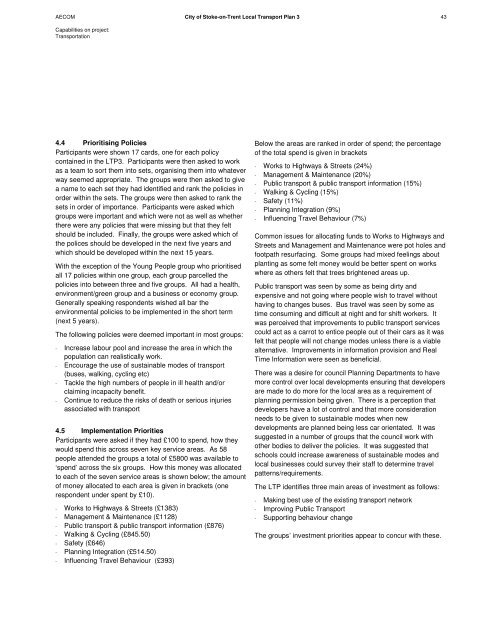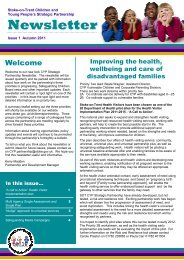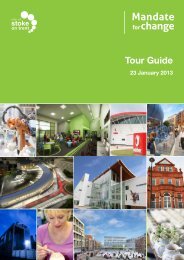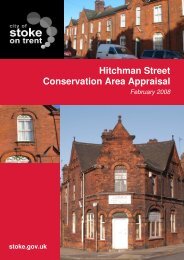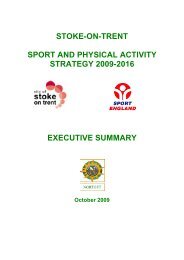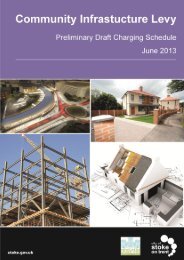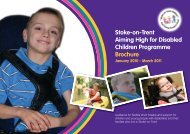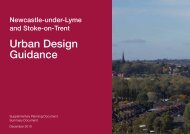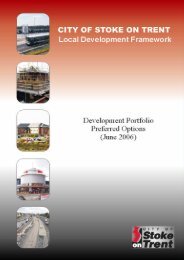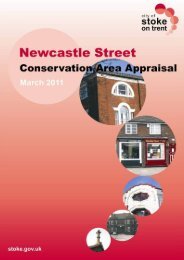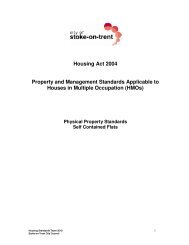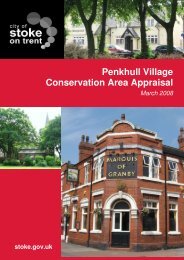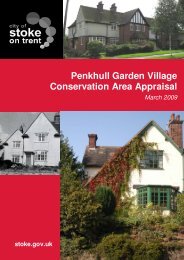City of Stoke-on-Trent Local Transport Plan 3 Focus Groups
City of Stoke-on-Trent Local Transport Plan 3 Focus Groups
City of Stoke-on-Trent Local Transport Plan 3 Focus Groups
- No tags were found...
You also want an ePaper? Increase the reach of your titles
YUMPU automatically turns print PDFs into web optimized ePapers that Google loves.
AECOM <str<strong>on</strong>g>City</str<strong>on</strong>g> <str<strong>on</strong>g>of</str<strong>on</strong>g> <str<strong>on</strong>g>Stoke</str<strong>on</strong>g>-<strong>on</strong>-<strong>Trent</strong> <strong>Local</strong> <strong>Transport</strong> <strong>Plan</strong> 3 43Capabilities <strong>on</strong> project:<strong>Transport</strong>ati<strong>on</strong>4.4 Prioritising PoliciesParticipants were shown 17 cards, <strong>on</strong>e for each policyc<strong>on</strong>tained in the LTP3. Participants were then asked to workas a team to sort them into sets, organising them into whateverway seemed appropriate. The groups were then asked to givea name to each set they had identified and rank the policies inorder within the sets. The groups were then asked to rank thesets in order <str<strong>on</strong>g>of</str<strong>on</strong>g> importance. Participants were asked whichgroups were important and which were not as well as whetherthere were any policies that were missing but that they feltshould be included. Finally, the groups were asked which <str<strong>on</strong>g>of</str<strong>on</strong>g>the polices should be developed in the next five years andwhich should be developed within the next 15 years.With the excepti<strong>on</strong> <str<strong>on</strong>g>of</str<strong>on</strong>g> the Young People group who prioritisedall 17 policies within <strong>on</strong>e group, each group parcelled thepolicies into between three and five groups. All had a health,envir<strong>on</strong>ment/green group and a business or ec<strong>on</strong>omy group.Generally speaking resp<strong>on</strong>dents wished all bar theenvir<strong>on</strong>mental policies to be implemented in the short term(next 5 years).The following policies were deemed important in most groups:- Increase labour pool and increase the area in which thepopulati<strong>on</strong> can realistically work.- Encourage the use <str<strong>on</strong>g>of</str<strong>on</strong>g> sustainable modes <str<strong>on</strong>g>of</str<strong>on</strong>g> transport(buses, walking, cycling etc)- Tackle the high numbers <str<strong>on</strong>g>of</str<strong>on</strong>g> people in ill health and/orclaiming incapacity benefit.- C<strong>on</strong>tinue to reduce the risks <str<strong>on</strong>g>of</str<strong>on</strong>g> death or serious injuriesassociated with transport4.5 Implementati<strong>on</strong> PrioritiesParticipants were asked if they had £100 to spend, how theywould spend this across seven key service areas. As 58people attended the groups a total <str<strong>on</strong>g>of</str<strong>on</strong>g> £5800 was available to‘spend’ across the six groups. How this m<strong>on</strong>ey was allocatedto each <str<strong>on</strong>g>of</str<strong>on</strong>g> the seven service areas is shown below; the amount<str<strong>on</strong>g>of</str<strong>on</strong>g> m<strong>on</strong>ey allocated to each area is given in brackets (<strong>on</strong>eresp<strong>on</strong>dent under spent by £10).- Works to Highways & Streets (£1383)- Management & Maintenance (£1128)- Public transport & public transport informati<strong>on</strong> (£876)- Walking & Cycling (£845.50)- Safety (£646)- <strong>Plan</strong>ning Integrati<strong>on</strong> (£514.50)- Influencing Travel Behaviour (£393)Below the areas are ranked in order <str<strong>on</strong>g>of</str<strong>on</strong>g> spend; the percentage<str<strong>on</strong>g>of</str<strong>on</strong>g> the total spend is given in brackets- Works to Highways & Streets (24%)- Management & Maintenance (20%)- Public transport & public transport informati<strong>on</strong> (15%)- Walking & Cycling (15%)- Safety (11%)- <strong>Plan</strong>ning Integrati<strong>on</strong> (9%)- Influencing Travel Behaviour (7%)Comm<strong>on</strong> issues for allocating funds to Works to Highways andStreets and Management and Maintenance were pot holes andfootpath resurfacing. Some groups had mixed feelings aboutplanting as some felt m<strong>on</strong>ey would be better spent <strong>on</strong> workswhere as others felt that trees brightened areas up.Public transport was seen by some as being dirty andexpensive and not going where people wish to travel withouthaving to changes buses. Bus travel was seen by some astime c<strong>on</strong>suming and difficult at night and for shift workers. Itwas perceived that improvements to public transport servicescould act as a carrot to entice people out <str<strong>on</strong>g>of</str<strong>on</strong>g> their cars as it wasfelt that people will not change modes unless there is a viablealternative. Improvements in informati<strong>on</strong> provisi<strong>on</strong> and RealTime Informati<strong>on</strong> were seen as beneficial.There was a desire for council <strong>Plan</strong>ning Departments to havemore c<strong>on</strong>trol over local developments ensuring that developersare made to do more for the local area as a requirement <str<strong>on</strong>g>of</str<strong>on</strong>g>planning permissi<strong>on</strong> being given. There is a percepti<strong>on</strong> thatdevelopers have a lot <str<strong>on</strong>g>of</str<strong>on</strong>g> c<strong>on</strong>trol and that more c<strong>on</strong>siderati<strong>on</strong>needs to be given to sustainable modes when newdevelopments are planned being less car orientated. It wassuggested in a number <str<strong>on</strong>g>of</str<strong>on</strong>g> groups that the council work withother bodies to deliver the policies. It was suggested thatschools could increase awareness <str<strong>on</strong>g>of</str<strong>on</strong>g> sustainable modes andlocal businesses could survey their staff to determine travelpatterns/requirements.The LTP identifies three main areas <str<strong>on</strong>g>of</str<strong>on</strong>g> investment as follows:- Making best use <str<strong>on</strong>g>of</str<strong>on</strong>g> the existing transport network- Improving Public <strong>Transport</strong>- Supporting behaviour changeThe groups’ investment priorities appear to c<strong>on</strong>cur with these.


